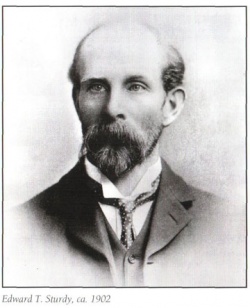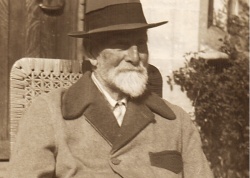E. T. Sturdy: Difference between revisions
Pablo Sender (talk | contribs) No edit summary |
Pablo Sender (talk | contribs) No edit summary |
||
| Line 6: | Line 6: | ||
== Theosophical involvement== | == Theosophical involvement== | ||
[[File:E. T. | [[File:E. T. Sturdy2.jpg|right|250px]] | ||
E. T. Sturdy went to New Zealand at the age of 19. A few years later, in 1884, he heard about the [[Theosophical Society]] through a friend and sent a letter to [[Adyar (campus)|Adyar]]. He joined the Society in October 1885, with only eight New Zealanders having done this before him. The next year he went to India and joined [[Henry Steel Olcott|H. S. Olcott]] who was on a tour in Northwest India. He then went to London and met [[Helena Petrovna Blavatsky|H. P. Blavatsky]].<ref>Robert S. Ellwood, ''Islands of the Dawn'', (Honolulu: University of Hawaii Press, 1993), 98-99.</ref> It may be at this time when she dictated to him her [[HPB's Diagram of Meditation|Diagram of Meditation]]. | E. T. Sturdy went to New Zealand at the age of 19. A few years later, in 1884, he heard about the [[Theosophical Society]] through a friend and sent a letter to [[Adyar (campus)|Adyar]]. He joined the Society in October 1885, with only eight New Zealanders having done this before him. The next year he went to India and joined [[Henry Steel Olcott|H. S. Olcott]] who was on a tour in Northwest India. He then went to London and met [[Helena Petrovna Blavatsky|H. P. Blavatsky]].<ref>Robert S. Ellwood, ''Islands of the Dawn'', (Honolulu: University of Hawaii Press, 1993), 98-99.</ref> It may be at this time when she dictated to him her [[HPB's Diagram of Meditation|Diagram of Meditation]]. | ||
| Line 30: | Line 30: | ||
== Norburton Hall == | == Norburton Hall == | ||
[[File:E. T. Sturdy.jpeg|right|250px|thumb|E. T. Sturdy at Norburton Hall]] | |||
==Online resources== | ==Online resources== | ||
===Articles and pamphlets=== | ===Articles and pamphlets=== | ||
Revision as of 22:20, 14 January 2014

Edward Toronto Sturdy (1860–1957) was a a Sanskrit scholar, student of Hinduism and Buddhism, and a member of the Theosophical Society.
Theosophical involvement
E. T. Sturdy went to New Zealand at the age of 19. A few years later, in 1884, he heard about the Theosophical Society through a friend and sent a letter to Adyar. He joined the Society in October 1885, with only eight New Zealanders having done this before him. The next year he went to India and joined H. S. Olcott who was on a tour in Northwest India. He then went to London and met H. P. Blavatsky.[1] It may be at this time when she dictated to him her Diagram of Meditation.
Mr. Sturdy returned to New Zealand by way of New York where he met W. Q. Judge. He settled in Wellington and gathered some students around, which eventually lead to the formation of the first lodge in the country, the Wellington Lodge, chartered in November 1888:
Among its members were Sir Harry Albert ATKINSON, Prime Minister of New Zealand; his wife Anne E. Atkinson; their son, E. Tudor Atkinson; M. van Staveren, a Jewish rabbi; H. M. Stowell (Hare Hongi), a Maori tohunga (priest); and Edward Tregear, a poet and Maori scholar, who wrote a book about the similarities of the Hindu and Maori languages.[2]
However, Mr. Sturdy left for England in December 1888 to become a student of Mme. Blavatsky. After his departure the Wellington Lodge ceased to exist, although it was rechartered in 1894.
Mr. Sturdy became a member of the Esoteric Section of Theosophy and one of the "E.S.T. Council" appointed by H.P.B. He was also part of the European Advisory Council formed in July, 1890, to assist her in her new function as the Presidential authority of the Theosophical Society in Europe. The other members of the Council were Annie Besant, W. Kingsland, Herbert Burrows, A. P. Sinnett, H. A. W. Coryn, and G. R. S. Mead.[3] Mr. Sturdy was also a member of the Inner Group formed by HPB in August 1890.
On April, 1891, ill and few weeks before dying, HPB was concerned that Mr. Sturdy had also been taken ill with influenza. When it was suggested that Mr. Mead should bring him to be nursed at Headquarters, she was much pleased and insisted on his being sent for at once.[4]
Mr. Sturdy was present at the meeting at 19 Avenue Road on May 27, 1891, when the E.S. was reorganized immediately after the death of H.P.B.
In August 1893 he published an article on Gurus and Chelas in Lucifer. The latter induced Annie Besant to publish another article in October, 1893, taking a stand against the spirit behind Mr. Sturdy's.
Theosophy was not his only inspiration. In 1940 he wrote: "What I have, I owe largely to H. P. Blavatsky, to some extent to Anna Kingsford and Edward Maitland, and perhaps, most of all, to the Vedanta and Buddhist teachings".[5]
Sanskrit scholar
During the latter part of 1893, Mr. Sturdy met Swami Shivananda. In 1895 Swami Vivekananda had been planning a visit to London for some time. Miss Henrietta Müller, who had already met him in America, extended to him an invitation to come to London, and Mr. E. T. Sturdy had requested him to stay at his home there. Eventually, Swami Vivekananda and Mr. Sturdy began to work together on an English translation of the Bhakti aphorisms of Narada. After a two months' stay in England, before leaving, he arranged that Mr. Sturdy should conduct classes in London till the arrival of a new Swami from India.[6]
Norburton Hall
Online resources
Articles and pamphlets
by E. T. Sturdy and a reply by Annie Besant
- Reminiscences of Swami Vivekananda by E. T. Sturdy
- Letters from Swami Vivekananda to Mr. E. T. Sturdy, April 24, 1895 and September 14, 1899.
- Norburton Hall at DorsetLife
- The Story of Norburton Hall at Burtonbradstock Online
- Norburton Hall History at NorburtonHall.com
Notes
- ↑ Robert S. Ellwood, Islands of the Dawn, (Honolulu: University of Hawaii Press, 1993), 98-99.
- ↑ Philip Harris, Theosophical Encyclopedia (Quezon City: Theosophical Publishing House, 2006), 449.
- ↑ Helena Petrovna Blavatsky, Collected Writings vol. XII (Wheaton, IL: Theosophical Publishing House, 1980), 264.
- ↑ How She Left Us by Laura M. Cooper.
- ↑ Robert S. Ellwood, Islands of the Dawn, (Honolulu: University of Hawaii Press, 1993), 98.
- ↑ See [1] Vivekananda A Biography, Ch. 9, "Experiences In The West"] by Swami Nikhilananda

